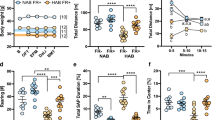Abstract
The existence of internal relationships between measures of investigative and seeking types of activity and the level of anxiety was demonstrated in rats. Individual measures of investigative activity and levels of anxiety were measured using classical methods-the open field test and the elevated plus maze test. The productivity of directed seeking activity was studied using methods developed by ourselves in a universal problem-solving box. Cluster analysis demonstrated hierarchical groups in the population with similar quantitative-qualitative behavioral characteristics.
Similar content being viewed by others
References
A. S. Batuev, E. P. Vinogradova, and O. I. Polyakova, “Effects of stress on pregnant rats on the level of anxiety in their offspring,” Zh. Vyssh. Nerv. Deyat., 46, No. 5, 558–566 (1996).
C. Yu. Buslovich, A. I. Kotelenets, and R. M. Fridlyand, “In integral method for evaluating the behavior of white rats in the open field,” Zh. Vyssh. Nerv. Deyat., 39, No. 1, 168–174 (1989).
G. A. Vartanyan and V. S. Petrov, Emotion and Behavior [in Russian], Nauka, Leningrad (1989).
N. R. Grigor’ev, An Experimental Method for Measuring Searching Activity [in Russian], Patent No. 1 776 385 (1992).
N. R. Grigor’ev, “An experimental method for studying searching activity and refusal to search in rats,” Zh. Vyssh. Nerv. Deyat., 46, No. 2, 400–405 (1996).
N. R. Grigor’ev, “Functional organization of searching activity in food-related and defensive behavior,” Zh. Vyssh. Nerv. Deyat., 48, No. 1, 75–83 (1998).
N. R. Grigor’ev, E. F. Kirichenko, Yu. B. Temper, and G. E. Cherbikova, “Dynamics of integral parameters of orientational-investigative and searching behavior in rats,” Zh. Vyssh. Nerv. Deyat., 48, No. 5, 868–876 (1998).
N. R. Grigor’ev, and S. F. Artemchuk, and G. E. Cherbikova, “Parameters of searching activity in the structure of food-related, defensive, and drinking motivations (comparative analysis),” Zh. Vyssh. Nerv. Deyat., 51, No. 3, 383–385 (2001).
N. R. Grigor’ev, V. I. Tikhanov, and M. L. Plastinin, “Searching activity and its pharmacological regulation by isothiorbamin,” Dal’nevostochnyi Med. Zh., 3, 37–41 (2001).
N. R. Grigor’ev, M. L. Plastinin, and A. A. Brash, A Method for Recording and Analyzing Measures of Searching Activity in Animals in a Problem Box [in Russian], Russian Federation patent No. 2 204 942; Byull., 3 (2002).
S. A. Grigor’yan, “General cognitive ability: 1. The state of the question and potentials for further studies in mice,” Zh. Vyssh. Nerv. Deyat., 54, No. 6, 802–810 (2004).
E. V. Gubler, Informatics in Pathology, Clinical Medicine, and Pediatrics [in Russian], Meditsina, Leningrad (1990).
Z. A. Zorina and I. I. Poletaeva, Zoopsychology. Elementary Thought in Animals [in Russian], Aspekt Press (2003).
D. V. Kolesov, Evolution of the Mind and the Nature of Drug Addition [in Russian], Pedagogika, Moscow (1991).
Yu. N. Korystov, “Emotion, stress, smoking, alcohol consumption, and cancer: correlational and causal relationships,” Zh. Vyssh. Nerv. Deyat., 47, No. 4, 627–637 (1997).
V. S. Rotenberg and V. V. Arshavskii, Searching Activity and Adaptation [in Russian], Nauka, Moscow (1984).
P. V. Simonov, Lectures on Brain Operation. The Need-Information Theory of Higher Nervous Activity [in Russian], Institute of Psychology, Russian Academy of Sciences, Moscow (1998).
E. N. Sokolov, Mechanisms of Memory. Experience of Experimental Studies [in Russian], Moscow State University, Moscow (1969).
Physiology of Behavior. Neurophysiological Features [in Russian], Nauka, Leningrad (1986).
Physiology of Behavior. Neurobiological Features [in Russian], Nauka, Leningrad (1987).
R. Shoven, Animal Behavior [Russian translation], Mir, Moscow (1972).
A. Beunzen and C. Belzung, “Link between emotional memory and anxiety states: a study by principal component analysis,” Physiol. Behav., 58, No. 1, 111–118 (1995).
N. R. Grigoryev, V. A. Dorovskich, and M. L. Plastinin, “Experimental discovery cognitive and anxiolytic properties of antioxidants and the other drugs by means of device and way patented of Amur State Medical Academy”, in: China and Russia Pharmaceutical Forum. Studies or Drugs Used in Traditional Therapy, Harbin, China (2004), pp. 31–35.
C. S. Hall, “Emotional behaviour in the rat. II. The relationship between emotionality and ambulatory activity,” J. Comp. Physiol. Psychol., 22, 345–356 (1936).
K. C. Montgomery, “The relation between fear induced by novel stimulation and exploratory behavior,” J. Comp. Physiol. Psychol., 48, 254–260 (1955).
S. Pellow and S. E. File, “Anxiolytic and anxiogenic drug effects on exploratory activity in an elevated plus-maze: a novel test of anxiety in the rat,” Pharmacol. Biochem. Behav., 24, No. 3, 525–529 (1986).
R. L. Ribeiro, R. Andreatini, C. Wolfram, et al., “The ‘anxiety state’ and its relation with rat model of memory and habituation,” Neurobiol. Learn. Mem., 72, No. 2, 78–94 (1999).
M. E. P. Seligman, Helplessness. On Depression Development and Death, Freeman, San Francisco (1975).
R. H. Silva and R. Frussa-Filho, “The plus-maze discriminative avoidance task; a new model to study memory-anxiety interaction. Effect of chlordiazepoxide and caffeine,” J. Neurosci. Meth., 102, No. 2, 117–125 (2000).
Author information
Authors and Affiliations
Additional information
__________
Translated from Rossiiskii Fiziologicheskii Zhurnal imeni I. M. Sechenova, Vol. 93, No. 8, pp. 817–826, August, 2007.
Rights and permissions
About this article
Cite this article
Grigor’ev, N.R., Batalova, T.A., Kirichenko, E.F. et al. Typological features in the behavior of rats. Neurosci Behav Physi 38, 597–603 (2008). https://doi.org/10.1007/s11055-008-9019-0
Received:
Revised:
Published:
Issue Date:
DOI: https://doi.org/10.1007/s11055-008-9019-0




